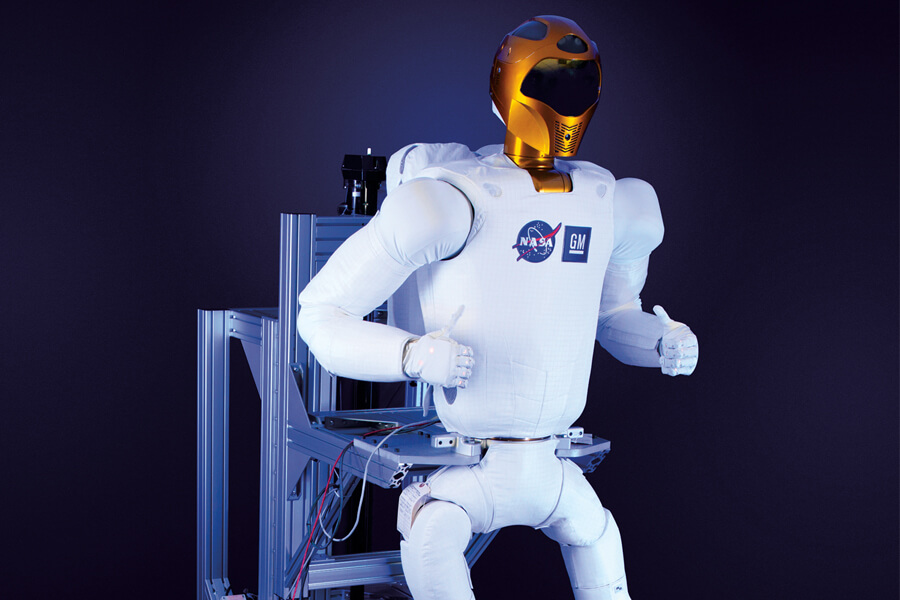Not many people can claim that they programmed the first humanoid robot in space. Julia Badger (BSME ’03) saw her hard work pay off with Robonaut, a sleek feat of humanoid technology that flew on the International Space Station. Today, as the autonomous systems technology discipline lead at NASA’s Johnson Space Center, she is designing the next generation of autonomous robots that will help humans explore the solar system.
“I was the first technical person in my family,” Badger says. “I just loved solving problems. Then in 9th grade, I read the book
For anything space-related, Purdue was the obvious choice. And mechanical engineering was the perfect field. “Mechanical engineers can do anything,” Badger says. “They know a little bit about electrical things, they work with materials, they do some civil engineering. They touch a little bit of everything. That’s why I chose it.”
She delved into systems and controls, including mechatronics classes taught by George Chiu, assistant dean for global engineering programs and a professor of mechanical engineering. “I remember spending all night in the computer lab trying to get that robot to climb a hill and drop a golf ball into a hole,” Badger says. “I don’t think we were ever successful at it, but we had fun trying.”
She also began volunteering with Purdue FIRST, a group of students who assist high schoolers with robotics competitions. “Julia was really an outstanding student,” says Steve Florence, Purdue FIRST’s advisor. “I remember her working on those FIRST robots. She always wanted to become an astronaut, but even if she herself didn’t make it into space, it’s so exciting to see her robots take the trip.”
NASA soon entered the picture, thanks to Purdue’s co-op program that allows students to alternate semesters between studying at Purdue and working in industry. “Co-ops are so important, and NASA was my first choice,” says Badger. She interviewed and was selected. “I started working with the X-38, which was supposed to be the lifeboat for the International Space Station, but that got cancelled, so I moved to robotics. I’ve been there ever since.”
After a master’s degree and Ph.D. from Caltech, Badger returned to Johnson Space Center to work full-time with robotics. She applied her systems expertise to projects like the Space Exploration Vehicle, a pressurized rover that would allow astronauts to explore other planets. Soon she joined the team behind the most ambitious robotics project at NASA: Robonaut.
“Robonaut is a humanoid dexterous robot,” Badger explains. “It’s designed to function like humans and share the same space as humans, doing mundane tasks that astronauts would otherwise have to do. Things break all the time, and Robonaut is essentially the repairman.” Robonaut also became a celebrity, with its own social media following and photos with dozens of dignitaries, from George Takei to One Direction.
Badger served as application designer for Robonaut, designing and executing all the tests performed by the robot after it launched to the International Space Station in 2011. Robonaut’s dexterity allowed it to grasp even the softest of items, clean surfaces, flip switches and manipulate experiments on board. They even attempted to give Robonaut mobility by manufacturing legs, for which Badger designed the control system.
Unfortunately, Robonaut developed significant hardware problems. Despite many repair attempts by astronauts — even though the robot was never designed to be serviced in space — Robonaut returned to Earth in 2018 for a full check-up.
This could have been a crippling discouragement, but Badger sees it as the next logical step in a process. “We’re in the business of developing new technologies,” she says. “Robonaut is just one project, and the technologies we developed for Robonaut will transfer forward into the next phase of space exploration.”
Next steps
Because the Gateway will only be manned for a few weeks every year, autonomous robots will play a huge role in its operation.
“This is the first time we’ve had a complex human spacecraft which is uncrewed most of the time, while we still expect it to function when people get there,” Badger says. “We plan to have all sorts of robotic systems on board to enable that spacecraft to autonomously take care of itself.”
While autonomous robots and rovers have conducted purely scientific missions in the past, Badger’s team is focused on advancing human space exploration. “The goal of these robots is to enable human beings to visit other planets and do meaningful work there,” she says. “We imagine robots on the Gateway doing experiments to test whether humans can survive and adapt to certain environments. There’s a lot of secrets that we haven’t unlocked on the moon and Mars, and robots can help us accomplish that.”
Photo At Top:

NASA’s Robonaut 2 with the newly developed climbing legs, designed to give the robot mobility in zero gravity. With legs, R2 will be able to assist astronauts with both hands while keeping at least one leg anchored to the station structure at all times.
NASA photo
“There’s a lot of secrets that we haven’t unlocked on the moon and Mars, and robots can help us accomplish that.”
— Julia Badger
